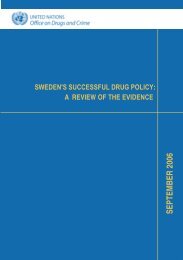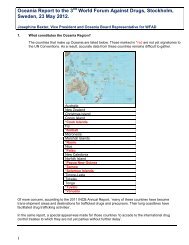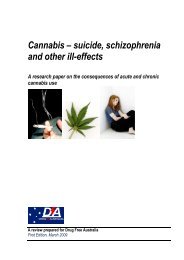International Research Compendium - Drug Free Australia
International Research Compendium - Drug Free Australia
International Research Compendium - Drug Free Australia
You also want an ePaper? Increase the reach of your titles
YUMPU automatically turns print PDFs into web optimized ePapers that Google loves.
much more pure than it used to be, snorting it has become an effective and popular<br />
route of administration.<br />
Snorted ( powder )cocaine is not nearly as reinforcing ( and thus addictive ) as<br />
smoked ( crack ) cocaine, simply because smoking can deliver a much larger amount<br />
of cocaine to the brain more rapidly than snorting. The rush ( the mood change ) that<br />
results from smoked cocaine is much more profound that that induced by snorting.<br />
<strong>Drug</strong> continuation rates are highest for drugs that are more tolerated. ( from highest<br />
to lowest continuation rates: alcohol, cigarettes, marijuana and cocaine. )<br />
Continuation rates, like levels of drug use within the society, reflects primarily the<br />
environment in which drug use occurs rather than any pharmacological property of<br />
the drug.<br />
The development of addiction: Multiple factors are into play<br />
The reasons for drug addiction are a combination of the factors of heredity,<br />
environment , the use of psychoactive drugs and the personality of the individual.<br />
Because individual personalities, heredity, physiology and lifestyles vary, each<br />
person’s resistance or susceptibility to drug use also varies.<br />
The drug user with a higher biological predisposition for addiction likes the (initial)<br />
drug high(s) more than do users who lack this heightened risk. The more important<br />
the use of drugs is to anyone, the more rewarding the drug experience, the greater<br />
the risk of addiction. In contrast, many people who fool around with drugs and then<br />
drop them, without ever progressing to having a love affair with drug use, say that the<br />
drugs did little or nothing for them. Although it is not possible at this time to test for<br />
genetic trait associated with addiction, it is possible to determine just how much the<br />
use of the addictive substance means to the person using it by asking the person.<br />
Diversity of risk does not mean that some people are vulnerable to addiction and<br />
others are not, but it does mean that some people are relatively more vulnerable than<br />
others. A person who starts with a low inherited susceptibility and low environmental<br />
stress might need intense use of drugs to push him/her into addiction. The greater<br />
the environmental stress, the fewer drugs are needed to develop addiction. But<br />
everyone can become addicted to drugs if they repeat the experience of drug reward<br />
often enough!!<br />
Environmental change can trigger loss of control of drug use<br />
When a person uses a substance for a long period of time without loss of control and<br />
then later looses control of drug use, there may have been an environmental change<br />
that shifted drug use from benign to malignant. The change in the user’s life triggered<br />
the previously latent progression of the disease of addiction. The pressures and<br />
influences of the environment actually shape and connect nerve cells. The stronger<br />
the environmental influences and the more they are repeated, the more indelible the<br />
imprinting on the brain. These influences include physical/emotional/sexual abuse<br />
during adolescence, poor nutrition, or social attitudes that permit drug use.<br />
People can also become more susceptible to use drugs if society tells them in word<br />
and deed that drinking, smoking and using drugs is a normal part of life.<br />
The environment can make a person more liable to use and abuse psychoactive<br />
substances:<br />
-If stress is common in the home.<br />
5






